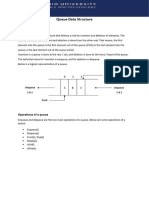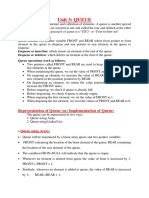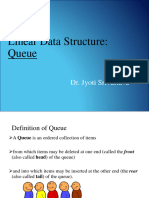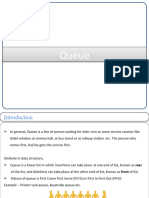0 ratings0% found this document useful (0 votes)
10 views16 pagesUnit-3 DS Queue
Data structure course queue for +3 2nd sem core 3 unit 3
Uploaded by
subhransupatra2005Copyright
© © All Rights Reserved
We take content rights seriously. If you suspect this is your content, claim it here.
Available Formats
Download as PDF or read online on Scribd
0 ratings0% found this document useful (0 votes)
10 views16 pagesUnit-3 DS Queue
Data structure course queue for +3 2nd sem core 3 unit 3
Uploaded by
subhransupatra2005Copyright
© © All Rights Reserved
We take content rights seriously. If you suspect this is your content, claim it here.
Available Formats
Download as PDF or read online on Scribd
You are on page 1/ 16
Introduction to Queue
A queue is an ordered collection of items in which deletion takes place at one
which is called the front of the queue, and insertion at the other end, which is calledithe
rear of the queue.
The queue is a ‘First In First Out’ system (FIFO). In a time-sharing system, the
be many tasks waiting in the queue, for access to disk storage or for using the
The queues in a bank, or railway station counter are examples of queue. The
person in the queue is the first to be attended.
The two main operations in the queue are insertion and deletion of items. The
has two pointers, the front pointer points to the first element of the queue and the!
pointer points to the last element of the queue. i
STACKAND. QUEUE
| Reet Enqueue
Dequeue 3
Figure - 12: Queue
3.1] TYPES OF QUEUES
J. Simple Queue — Elements are inserted at the rear and removed from the front.
2. Circular Queue — The rear wraps around to the front when it reaches the end of the
array.
3, Priority Queue — Elements are dequeued based on priority instead of order.
4, Deque (Double-ended Queue) — Elements can be inserted and removed from both
ends.
EEEI OPERATIONS ON A QUEUE
1. Enqueue (Insertion) — Adds an element to the rear.
2. Dequeue (Removal) — Removes an element from the front.
3. Front (Peek) — Returns the front element without removing it.
4, isEmpty — Checks if the queue is empty.
5, isFull — Checks if the queue is full (in the case of a fixed-size implementation).
3.12.1 : Representation of Queue
© Queue Representation using Array
© — Queue Representation using Linked List
3.12.2 : Array Representation of Queue
When the queue is represented using array. First size of the array is defined and let say 5.
nt is initializing to -1.Figure 13 shows the array representation of the queue.
[0] 1) 2) 1 [4] [5]
2] 6)
L LL | Rear=1
Front=1.
Figure - 13: Array Representation of Queue
Rear and Fro.
a
218
Enqueue (Insert at Rear End)
© To insert an item into the queue, first it should be verified whether the queue ig,
not. IFthe queue is full, a new item cannot be inserted into the queue, The equi
FRONT=NULL indicates that the queue is empty. If the queue is not full, iter
inserted at the rear end. When an item is added to the queue, the value of tae
incremented by 1. Tis
© In queue we need to maintain two data pointers, front and rear. Operations on,
are comparatively difficult to implement than that of stacks Mere
Algorithm for Insertion
Step 1 - Check if the queue is full.
Step 2 - If the queue is full, produce overflow error and exit.
Step 3 - If the queue is not full, increment rear pointer to point the next empty space,
Step 4 - Add data element to the queue location, where the rear is pointing.
Step 5 - return success.
Pseudo code:
If Rear= Size-1 then
print ‘Queue is Full”
if Front—1 the
update Front=0
Rear=Rear+1
Queue[Rear]=element
‘Where size is the maximum size of the queue
Figure 14 shows the enqueue operation on the queue. Initially the queue is empty. So Frea
is -1 and Rear is at -1, Insertion takes place at Rear. So the Rear is updated by ! when
element was inserted.
C Implementation for Insertion in Queue:
void enqueue(int value) {
if (rear == SIZE - 1) {
printf("Queue is Full! Cannot enqueue %ad\n", value);
return;
}
if (front = -1)
front = 0; // Set front to 0 when first element is added
reart+;
queue[rear] = value;
printf("Inserted %d into queue\n", value);
}
Alo) Any Ala Aly All ALS)
Rear=-1
Front=1
Front. Rear
Alo} Al) AR) AB) Ala] Als)
10 Enqueue 10
Front Rear
Alo) All AR] ABL ata) ats
Ti 7 Enqueue 20
——
Front Rear
AO) alt) Al] Al) Ala) Als]
aD oa 30 Enqueue 30
Ee,
Figure - 14: Insert Operation on Queue
Dequeue (Delete from Front End)
To delete an item from the stack, first it should be verified that the queue is not empty. If the
queue is not empty, the items are deleted at the front end of the queue. When an item is
deleted from the queue, Dequeue operaticn includes two tasks: access the data where front
is pointing and remove the data after access.
Step 1 - Check if the queue is empty.
Step 2 - If the queue is empty, produce underflow error and exit.
Step 3 - If the queue is not empty, access the data where front is pointing.
Step 4 - Increment front pointer to point to the next available data element.
Step 5 - Return success. the value of the front is incremented by 1.
Pseudo code:
If Front==-1 or Front>Rear then
Print “Queue is Empty
Element=Queue[Front]
Front=Front+1
If Front >Rear
Front =Rear =-1
C implementation for Dequeue Operation:
void dequeue() {
if (front = -1 || front > rear) {
Printf{"Queue is Empty! Cannot dequeue\n");
return;
}
Printf("Removed %d from queue\n", queue[front]);
front++;
// Reset queue when all elements are dequeued
if (front > rear) {
front = rear = -1;
}
}
Figure 15 shows the Dequeue operation on an array A of size 5.When an item is deleted
from the queue Front is updated to Front + 1.
Front
Rear
a ai) AR) ar) atl fay ats)
10 | 20 | 30 [40 [50 Rear=4
Front=0
Dequeue Operation
Front Rear
ato) | AB AB) |: AD)
20 | 30 [40 |50 Dequeue 10
Front Rear —T
30 740 [50 Dequeue 20 “
Front Rear
a) Aa Pas) Hay as)
40 [50 Dequeve 30
———
Figure - 15: Delete Operation on Queue
am 8 wR ok SY AACN hI
C code for the implementation of Queue with insertion and deletion operation.
#include
#define SIZE 5 // the maximum size of the queue to be 5
int queue[SIZE], front = -1, rear = -1;
// Function to insert an element into the queue (Enqueue)
void enqueue(int value) {
if (rear == SIZE - 1) {
printf(Queue is Full! %d\n", value);
return;
}
if (front = -1)
front = 0; // Set front to 0 when first element is added
reart+;
queue[rear] = value;
printf("Inserted %d into queue\n", value);
}
// Function to remove an element from the queue (Dequeue)
void dequeue() {
if (front == -1 || front > rear) {
printf("Queue is Empty! \n");
return;
}
printf("Removed %d from queue\n", queue[front]);"
front++;
// Reset queue when all elements are dequeued
if (front > rear) {
front = rear = -1;
}
}
// Function to display the queue
void display() {
if (front = -1) {
printf("Queue is Empty!\n");
return;
}
printf("Queue: ");
for (int i= frot
<= rear; i++) {
printf("%d ", queue[i]);
}
printf("\n");
}
// Main function to test the queue operations
int main() {
enqueue(10);
enqueue(20);
enqueue(30);
enqueue(40);
enqueue(50);
display; // Show queue contents
dequeueQ); // Removes 10
dequeue(); // Removes 20
display); // Show queue contents after deletion
return 0;
+
3.12.3 : Linked list-Representation of Queue
Due to the drawbacks of array, the array implementation cannot be used for the
scale applications where the queues are implemented. The alternative of
implementation is linked list implementation of queue.
Ina linked queue, each node of the queue consists of two parts i.e. data part
next part. Each element of the queue points to its immediate next element in the
In the linked queue, there are two pointers maintained in the memory i.e. front p
and rear pointer. The front pointer contains the address of the starting element ¢
queue while the rear pointer contains the address of the last element of the quet
There can be the two scenario of inserting this new node ptr into the linked q
front = NULL becomes true. In the second case, the queue contains more
element, The condition front = NULL becomes false.
Deletion operation removes the element that is first inserted among all th
elements. The condition front = NULL becomes true if the list is empty. Othe
we will delete the element that is pointed by the pointer front. @
STACK AND QUEUE i)
ror creating a node in Linked list structure is use as follows:
struct Node { :
int data;
struct Node* next;
1
// Front and Rear pointers
struct Node* front = NULL;
struct Node* rear = NULL;
Here, front and rear is two pointers referring to the node for insertion and deletion.
C functions to insert node in queue:
void enqueue(int value) {
struct Node* ptr = (struct Node*)malloc(sizeof{struct Node));
if (ptr == NULL) {
printf("Memory allocation failed!\n");
return;
}
ptr->data = value;
ptr->next = NULL;
if (rear = NULL) { // If queue is empty
front = rear = ptr;
} else {
rear->next = ptr;
rear = ptr;
}
printf("Inserted %d into queue\n", value);
}
C Function to delete element from linked is as follows:
void dequeue() {
if (front = NULL) {
printf("Queue is Empty! Cannot dequeue\n");
return; ‘
}
struct Node* temp = front;
printf("Removed %d from queue\n", front->data);
front = front->next;
if (front = NULL) // If queue becomes empty
eT
rear = NULL;
free(temp);
}
ERK) CIRCULAR QUEUE
© — A more efficient queue representation is obtained by regarding the array Qy
circular. Any number of items could be placed on the queue. This implementation
queue is called a circular queue because it uses its storage array as if it were q
instead of a linear list,
© There are two problems associated with linear queue, They are:
(a). Time consuming: linear time to be spent in shifting the elements to the
of the queue.
(b) Signaling queue fall even if the queue is having vacant position,
Let us consider a linear queue as shown in figure 16 as follows:
Front Rear
Alo) An) [= AB) AL |e
30 =| 40 50 55 ]
Figure - 16: Queue where front is at index 2 and rear is at index 5
queue is used.
In circular queue if we reach the end or inserting elements to it, it is possible to i
element at the beginning of the queue.
3.12.1 : Representation of Circular Queue
Let us consider a circular queue as shown in figure 17, which can hold maximum
six elements. Initially the queue is empty.
FR
cob,
Queue Empty
4 1 MAX =6
FRONT = REAR
COUNT =0
3 2 x
Circular Queue
FRONT =0
4 1 REAR = (REAR + 1) %6=5
COUNT = 5
3 as 2
Circular Queue
Now, insert 11 to the circular queue. Then circular queue status will be:
F
5 . o
R
a!
FRONT=0
3 t REAR = (REAR + 1) %6
COUNT = 1
3 2
Circular Queue
Insert new elements 22, 33, 44 and 55 into the circular queue. The circular queue status is
Now, delete an element. The element deleted is the element at the front of the circular
queue. So, 11 is deleted. The circular queue status is as follows:
5
F
a!
FRONT = (FRONT + 1)%6=1
1 REAR =5
COUNT = COUNT -1=4
3
Circular Queue
Again, delete an element. The element to be deleted is always pointed to by the FRONT
pointer, So, 22 are deleted. The circular queue status is as follows:
FRONT = (FRONT + 1)%6=2
REAR
COUNT = COUNT - 1 =3
Circular Queue
Again, insert another element 66 to the circular queue. The status of the circular queue iy
jf 3
FRONT=2
REAR = (REAR + 1) %6=0
COUNT = COUNT + 1=4
Circular Queue
Now, insert new elements 77 and 88 into the circular queue. The circular queue status is:
88 |i FRONT = 2, REAR =2
‘ REAR =REAR % 6=2
COUNT = 6
‘ 2 KS R i
Circular Queue j
dd
Now, if we insert an element to the circular queue, as COUNT = MAX we cannot ada
element to circular queue. So, the circular queue is full. |
r
§ qACKAND. QUEUE.
#include
Hinclude
#define SIZE S$ // Define the maxi
int queue[SIZE}, front = -1, year
ji Function to check if t} ;
int isFullQ { Tee i fal
return ((rear + 1) % SIZE = front);
}
// Function to check if the queue is empty
int isEmpty) {
return (front == -1);
}
// Function to enqueue (insert) an element
void enqueue(int value) {
if (isFullO) {
printf("Queue is Full! Cannot enqueue %d\n", value);
i i <
mum size of the circular queue
return;
}
if (isEmpty() {
front = rear = 0; // Initialize front and rear
pelse {
rear = (rear + 1) % SIZE; // Circular increment
}
queue[rear] = value;
printf("Inserted %d into queue\n", value);
}
// Function to dequeue (remove) an element
void dequeue() {
if GsEmpty() {
printf("Queue is Empty! Cannot dequeue\n");
return;
printi("Removed %d from queue\n", queue[front]);
yor
207
if (front == rear) {_// If only one element was present
front = rear = -1;
} else {
front = (front + 1) % SIZE; // Circular increment
}
}
// Function to display the queue
void display() {
if (isEmpty() {
printf("Queue is Empty!\n");
return;
}
printf("Queue: ");
int i= front;
while (1) {
printf{"%d ", queuefi);
if (i = rear) break;
i=(i+1)% SIZE; // Circular increment
}
printf("\n");
}
// Main function to test the queue operations
int main() {
enqueue(10);
enqueue(20);
enqueue(30);
‘enqueue(40);
enqueue(50);
display; // Show queue contents
dequeueQ); // Removes 10
dequeue(); // Removes 20
display();,// Show queue contents after deletion
enqueue(60);
enqueue(70);
t
sR ener
display0; // Show queue aft
ler addi
return 0; ling new clements
}
EAT
In the preceding secti
from which ec Wwe saw that a queue in which we insert items at one end and
Ve itemis at the other end. In this section we examine an extension
of the queue, whi <
queue, which provides a means to insert and remove items at both ends of the
queue. This data st ; n
double-ended pes ne is a deque. The word deque is an acronym derived from
peque is shown in figure 18.
Deletion s/ Be i> tree
aA
Ne
inser Deletion
front
Figure 18: Representation of deque
« A deque provides four operations
enqueue_front: insert an element at front.
dequeue_front: delete an element at front.
enqueue_rear: insert element at rear.
dequeue_rear: delete element at rear
ti : enqueue_front(3 3) [|] enqueve_rear(44) [||
dequeue_front(33)
enqueue_front(55) 22| dequeue_rear(44) ,
equeve.reat™)
; |
Insertion and Deletion in Dqeue
Ha DATA STRUCTURE
.
3.14.1
3.14.2 : Types of Priority Queue
There are two types of priority queue:
There are two variations of deque. They are:
(1) Input restricted deque (IRD)
(2) Output restricted deque (ORD)
An Input restricted deque is a deque, which allows insertions at one end but allows deletion,
at both ends of the list. +
An output restricted deque is a deque, which allows deletions at one end but allows insertion,
at both ends of the list.
ity Queue
In priority queue, the clements are inserted and deleted based on their priority. Each elemeny
is assigned a priority and the element with the highest priority is given importance ang
processed first.
Ifall the elements present in the queue have the same priority, then the first element is given
importance.
The priority queue moves the highest priority elements at the beginning of the priority
queue and the lowest priority elements at the back of the priority queue. It supports only
those elements that are comparable. Priority queue in the data structure arranges the elements
in either ascending or descending order.
(1) Ascending order priority queue: In ascending order priority queue, a lower priority number
Q)
is given as a higher priority in a priority. For example, we take the numbers from 1 to
arranged in an ascending order like 1,2,3,4,5; therefore, the smallest number, i.e., 1 is given
as the highest priority in a priority queue. ‘a
element with the
lowest priori
element with the
highest priority
Figure 20: Representation of a Priority Queue
Descending order priority queue: In descending order priority queue, a higher priority nunt
arranged in descending order like 5, 4, 3, 2, 1; therefore, the largest number, i-e., 5 i
as the highest priority in a priority queue.
”
og ND QUEUE
gi Al
i
pplications of Queue
Task Scheduling : Queues ¢
: S can be used to se ’ ity or the order
ia which they were receives d to schedule tasks based on priority
Resource Allocation : 7
wa . Queues can be used to manage and allocate resources, such as
printers or CPU processing time.
atch Processing : 7
Batch Processing Queues can be used to handle batch processing jobs, such as data
analysis or image rendering.
Message Buffering : bea
M ; ae vee NE ? Queues can be used to buffer messages in communication systems,
ae ‘Age qucues in messaging systems or buffers in computer networks.
Event Handling + Queues can be used to handle events in event-driven systems, such
as GUI applications or simulation systems,
Traffic Management + Queues can be used to manage traffic flow in transportation
systems, such as airport control systems or road networks.
Operating systems : Operating systems often use queues to manage processes and
resources. For example, a process scheduler might use a queue to manage the order in
which processes are executed.
Network protocols : Network protocols like TCP and UDP use queues to manage
packets that are transmitted over the network. Queues can help to ensure that packets
are delivered in the correct order and at the appropriate rate.
Printer queues : In printing systems, queues are used to manage the order in which
print jobs are processed. Jobs are added to the queue as they are submitted, and the
printer processes them in the order they were received.
Web servers : Web servers use queues to manage incoming requests from clients.
Requests are added to the queue as they are received, and they are processed by the
server in the order they were received.
Breadth-first search algorithm : The breadth-first search algorithm uses a queue to
explore nodes in a graph level-by-level. The algorithm starts at a given node, adds its
neighbours to the queue, and then processes each neighbour in turn.
aa 9
You might also like
- Understanding Queues: Concepts & ImplementationsNo ratings yetUnderstanding Queues: Concepts & Implementations47 pages

























































